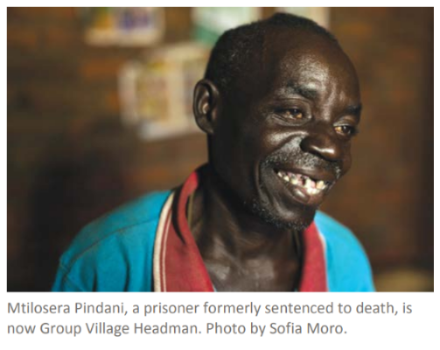New Report Finds That Malawi’s Traditional Leaders Oppose the Death Penalty, Favor Rehabilitation
On 18 April 2018, the Cornell Center on the Death Penalty Worldwide and Malawi’s Paralegal Advisory Services Institute (PASI) released their report on « Malawian Traditional Leaders’ Perspectives on Capital Punishment » before a group of public officials and stakeholders in Lilongwe.
The report analyses data from surveys of 102 traditional leaders in villages across Malawi. Clifford Msiska, the National Director of PASI, informed an audience in Lilongwe that over ninety percent of traditional leaders surveyed did not support the use of the death penalty to punish individuals convicted of murder. Only six traditional leaders stated that death was the appropriate penalty for murder. The rest preferred a term of years, life imprisonment with opportunity for early release, or (least frequently of all) life imprisonment with no opportunity for release.
The report grew out of the Malawi Resentencing Project. Following the Malawi Supreme Court’s decision to overturn the mandatory death penalty in Kafantayeni and others v Attorney General, the inmates sentenced under the now-unconstitutional law each received new sentence hearings. Of the more than 150 prisoners who were resentenced, 125 have now been released after serving their sentences.
In preparation for the resentencing hearings, PASI paralegals observed that many of the village chiefs supported the prisoner’s release. This ran counter to the popular view that traditional leaders supported the death penalty. Since no data existed to support or refute this assumption, Cornell Law School’s Center on the Death Penalty Worldwide teamed up with PASI and the London-based NGO Reprieve to carry out a survey to ascertain traditional leaders’ views on the death penalty. The survey focused on traditional leaders presiding over villages to which released prisoners had returned, sometimes decades after they had been sentenced to death.
The Cornell team that analyzed the survey responses found that traditional leaders opposed the death penalty for a variety of reasons. The most common explanation was rooted in the belief that people can change—and that prison is a place for reform. Many noted that rehabilitation is impossible if a prisoner is executed. As one traditional leader noted, “There is no reform in death.” Many traditional leaders also expressed concerns that innocent people could be hanged.
Traditional leaders also see the death penalty as enormously taxing on the community. Many families did not know whether their loved ones had been executed. For one family, the imposition of the death sentence was so shocking that his mother “mourned him for 2 weeks as if he was already dead.” Other families became convinced that the prisoner had been put to death. Many leaders noted that, rather than providing a sense of justice in the community and acting as a deterrent to others, losing a member of their community to a sentence of death “traumatized” local communities which have been left “in shock” and “depressed”. Members of close communities like those where many of the prisoners returned are often the indirect victims of a death sentence.
Closely linked to their conviction that prisoners are capable of reform is the notion that returning prisoners benefit the community and their family once released. Released prisoners have, according to the traditional leaders, served as mentors for young men and women who might be tempted to commit crime. One released former prisoner, Byson Kaula–who was wrongly convicted and sentenced to death–now works full time at Malawi’s only halfway house, counselling other recently released prisoners.
Another man, Mtilosera Pindani, has been elected traditional leader in his home village since his release. Countless others have married, had children, provided support to ailing parents, built schools, maintained roads, started businesses, and provided food from their farming. The story of Malawi’s released prisoners is a story of individual redemption, and of communities made whole by their return
Click image for full report:
